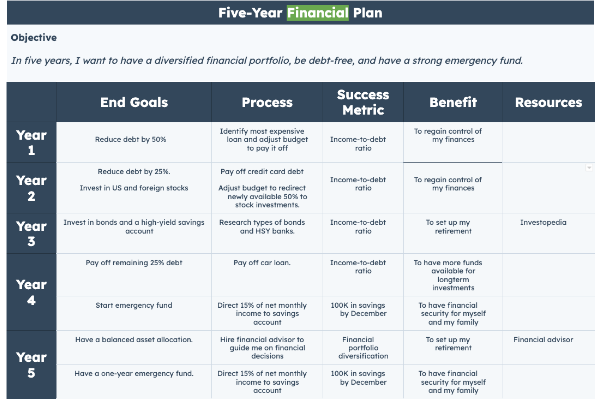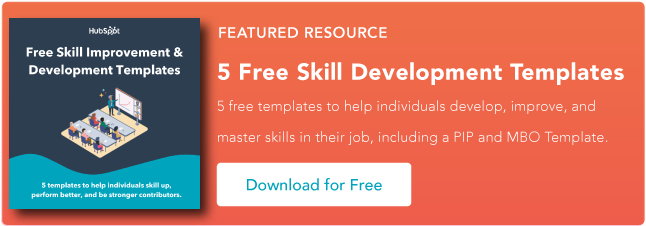![How to Create a 5-Year Plan You'll Actually Stick To [In 4 Steps]](https://www.liveseo.com/wp-content/uploads/2022/05/How-to-Create-a-5-Year-Plan-Youll-Actually-Stick-To.jpgkeepProtocol.jpeg)
One common question you’ll get asked in an interview is, “Where do you see yourself in five years?“
When it’s coming from a hiring manager, we usually have an answer ready. When it comes to your personal life, do you have a five-year plan?
In the most stressful times in my life, planning brings me great joy and peace. But who says you have to wait for the stress to come? In this article, we’ll outline why you should create a five-year plan and how to build one you’ll follow through with.
What is a 5-year plan?
A five-year plan is an outline of professional and/or personal goals you want to reach within the next five years. It usually includes broad goals relating to career, relationships, health, and finances that are broken down into action items and milestones.
Benefits of a 5-Year Plan
Whether professional or personal, a five-year plan can serve as a reset for your life. Who doesn’t like a fresh start?
After all, that’s why New Year’s resolutions are so popular. They give us something to look forward to. There’s also something to be said about writing out a detailed plan. It can be a great motivator to put something in motion.
Personally, I’ve said countless times that I want to be fluent in Spanish. However, it’s not until I write a detailed plan for how that it will become real.
This brings us to our next point: clarity. Sometimes, a path seems scarier than it actually is because we don’t actually know what it looks like.
Creating a plan is like pointing a flashlight in a dark road. A more accurate description is that it turns that dark, twisty road into a clear path forward. Doesn’t mean there won’t be any bumps in the road but at least you’ll know exactly where you’ll land and how to get there.
Lastly, a five-year plan can serve as a reminder of what’s at stake. In your daily life, it can be easy to forget that every day, we’re shaping our future.
The decisions we make today affect what our life will look like years from now. Having a visual reminder of this can keep you focused on your goals.
5-Year Plan Example
Using our downloadable five-year plan template, we were able to create a detailed five-year plan, broken down by year, process, success metric, benefit, and resources.

How to Make a 5-Year Plan
1. Know your “why.”
This is singlehandedly the most important step in creating a plan.
A clear “why” is your North star. It’s what will guide you throughout your journey and motivate you to keep moving forward.
It can take a while to narrow this down. You’ll know you have the answer when it’s linked to a core value or belief. Otherwise, you have to keep digging.
One way to get to this is by just asking the question over and over again. For instance:
- I want to learn American Sign Language. Why?
- To become more connected to another culture. Why?
- To broaden my perspective. Why?
- To be a more understanding, tolerant, and inclusive person.
Now, we’ve taken something at surface level and brought it down to a personal, human level.
2. Consider every aspect of your life.
When creating a five-year plan, you want to review your life as a whole and plan accordingly.
It’s not enough to plan for your professional career and not your personal one. After all, one impacts the other.
There are the core four that you should always have:
- Career
- Health (physical and mental)
- Finances
- Relationships
Depending on your goals, you can also add categories for religious or spiritual development, recreation, and service.
Don’t forget bucket-list items – have you been wanting to learn a new language? Or perhaps you want to visit every country in the world. Bucket list items are perfect for five-year plans because you can spread them out over a long period of time and have fun tracking your progress.
3. Make it S.M.A.R.T.
To give you the best chances of success, every goal should pass the SMART test. That means being:
- Specific – The vaguer your goal, the harder it will be to reach.
- Measurable – You must be able to quantify your goals because otherwise, how will you know you’ve reached it? This doesn’t always mean assigning a figure to it, it can also be a feeling.
- Achievable – While it’s good to push yourself beyond your limits, your goal should be attainable and realistic based on where you stand currently.
- Relevant – How does this goal fit within the bigger picture? Does it align with your personal values? What’s the impact on your life?
- Time-bound – It’s not enough to say it’s a five-year plan, you have to create a timeline and set milestones at specific points within your journey.
4. Start with the big ideas then narrow your focus.
When you’re first writing your five-year plan, start with the big idea from each category.
If you don’t know where to start, use this: “In five years, I want to be [fill in the blank].” This will help you figure out goals that you may not have vocalized before.
From there, break it down into bite-size pieces.
This means turning your ideas into action items that can be executed over a certain period of time, specifically from five years to monthly milestones.
Research will play a big role in this, as you will need to learn how to achieve some of your goals. For instance, say your five-year financial plan is to be debt-free.
That’s the big idea but you need to dive deeper. How exactly will you achieve that? Your research will likely suggest setting a budget, paying off your most expensive loan first, consolidating your debts, and more.
Once you know the key action items, you can break them down by year, month, and even week.
This is a S.M.A.R.T. goal in action. The more specific you are, the better you will be at fulfilling your five-year plan.
If you want to add more structure to your life and play a more active role in shaping your future, consider creating a five-year plan. While things may not pan out exactly as you’ve expected, you’ll be surprised at how close you’ll get to what you wished for.





